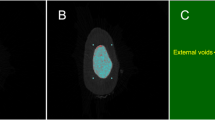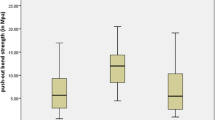Abstract
The present study evaluates the seal quality in the apex delta of uniradicular teeth filled with light-cured materials (calcium hydroxide, glass ionomer, and Flow-Fill Magic composite). A total of 45 roots prepared by the endo PTC/Dakin technique were used. All sample restorations were light-cured with 488-nm argon laser light. A 200-μm optical fiber introduced into the root canal delivered 100 mW of light power to the filler material. The fiber tip was positioned 5 mm away from the apex. Light was applied for 20 s. After curing, the samples were immersed in a methylene blue solution for 24 h. Then the samples were cut longitudinally and analyzed under a stereoscopic microscope for dye infiltration. For the sake of comparison, an additional group of ten samples submitted to conventional treatment with EndoREZ root canal sealer was also analyzed. The samples sealed with calcium hydroxide or with the glass ionomer presented less dye infiltration, as compared to those sealed with the Flow-Fill Magic composite. All products activated by fiber optic–delivered light showed superior sealing quality when compared with the self-activated EndoREZ sealer.




Similar content being viewed by others
References
Pommel L, Jacquot B, Camps J (2001) Lack of correlation among three methods for evaluation of apical leakage. J Endod 27:347–350
Pommel L, About I, Pashley D, Camps J (2003) Apical leakage of four endodontic sealers. J Endod 29:208–210
Mangin C, Yesilsoy C, Nissan R, Stevens R (2003) The comparative sealing ability of hydroxyapatite cement, mineral trioxide aggregate, and super ethoxybenzoic acid as root-end filling materials. J Endod 29:261–263
Çobankara FK, Adanir N, Belli S, Pashley DH (2002) A quantitative evaluation of apical leakage of four root-canal sealers. Int Endod J 35:979–984
Amazaki RY, Goya C, Tomita Y, Kimura Y, Matsumoto K (1999) Study on apical leakage of the teeth after argon laser treatment and obturation. J Clin Laser Med Surg 17:121–125
Ørstavik D, Nordahl I, Tibballs JE (2001) Dimensional change following setting of root canal sealer materials. Dent Mater 17:512–519
Watts DC, Marouf AS, Al-Hindi AM (2003) Photo-polymerization shrinkage-stress kinetics in resin-composites: methods development. Dent Mater 19:1–11
Sakaguchi RL, Berge HX (1998) Reduced light energy density decreases post-gel contraction while maintaining degree of conversion in composites. J Dent 26:695–700
Miyazaki M, Fukuishi K, Onose H (1999) Influence of light irradiation on the volumetric change of polyacid-modified resin composites. J Dent 27:149–153
Meniga A, Tarle Z, Ristic M, Sutalo J (1997) Pulsed blue laser curing of hybrid composite resins. Biomaterials 18:1349–1354
Mehl A, Hickeland R, Kunzelmann KH (1997) Physical properties and gap formation of light-cured composites with and without ‘soft-start-polymerization’. J Dent 25:321–330
Youngson CC, Jones JCG, Fox K, Smith IS, Wood DJ, Gale M (1999) A fluid filtration and clearing technique to assess microleakage associated with three dentine bonding systems. J Dent 27:223–233
Neo JO, Denehy GE, Boyer DB (1986) Effects of polymerization techniques on uniformity of cure of large diameter, photo-initiated composite resin restorations. J Am Dent Assoc 113:905–909
Fowler CS, Swartz ML, Moore BK (1994) Efficacy testing of visible light curing units. Operative Dent 19:47–52
Potts TV, Petrou A (1990) Laser photo-polymerization of dental materials with potential endodontic applications. J Endod 16:265–268
Potts TV, Petrou A (1991) Argon laser initiated resin photopolymerization for the filling of root canal in human teeth. Laser Surg Med 11:257–262
Wigdor HA, Walsh JT, Featherstone JDB, Virusi SR, Fried D, Waldvogel JL (1995) Laser in dentistry. Laser Surg Med 16:103–133
Zijp JR, ten Bosh JJ (1993) Theoretical model for the scattering of light by dentin and comparison with measurements. Appl Opt 32:411–415
Anic I, Shirasuka T, Matsumoto K (1995) Scanning electron microscopic evaluation of two compaction techniques using a composite resin as a root canal filling material. J Endod 21:595–598
Acknowledgements
The authors acknowledge the financial support of the Fundação de Amparo à Pesquisa do Estado de São Paulo—FAPESP, grant numbers PIPE/2000/1363600 and 1999/12531-1.
Author information
Authors and Affiliations
Corresponding author
Rights and permissions
About this article
Cite this article
Conrado, L.A.L., Munin, E., Frois, Ì.M. et al. Root apex sealing with different filling materials photopolymerized with fiber optic–delivered argon laser light. Lasers Med Sci 19, 95–99 (2004). https://doi.org/10.1007/s10103-004-0306-x
Received:
Accepted:
Published:
Issue Date:
DOI: https://doi.org/10.1007/s10103-004-0306-x




